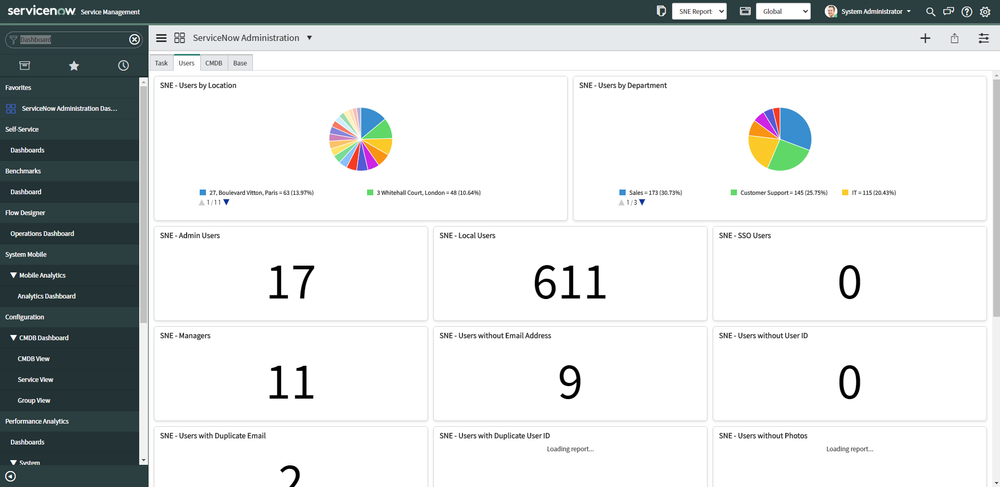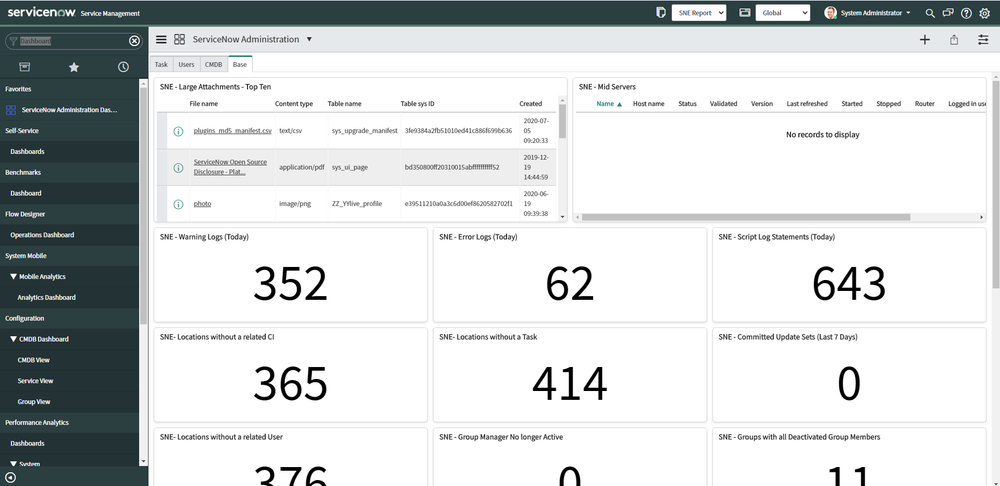Download a collection of administration and maintenance reports contained in a dashboard.
Maintenance Reports. Most ServiceNow instances have common issues that need periodic review. This dashboard includes many of these issues within a single dashboard
Scripted Filter Examples. Many of the reports use a scripted filter, which may be help as examples in building other reports.
Dashboard. You might consider using this dashboard as a starting point and building it out from there. Of course, if there is a report that is not relevant to your organization, just remove it from the dashboard.
Let me know in the comments of any reports to add and I will look into adding them to a later release!
Installation
Download zip file of Update Set: Admin_Reports_ServiceNowElite.xml
Login as an admin in destination instance. Always deploy into your development instance first and test before installing into production.
Left Navigator Bar > Retrieved Update Sets
Scroll to the bottom, under Related Links, click Import Update Set from XML
Select Retrieved Update Set
Preview and Commit Update Set
Usage
Open the Dashboard: ServiceNow Administration. It has 4 tabs, Task, Users, CMDB, and Base

Tab 1: Task
Active Requests with All Closed Items - Utilizes a scripted filter from the “SNEReports” script include. Cycles through active requests and finds ones with all closed requested items. Stages were not used in a workflow correctly and the Request isn’t being automatically closed when all Requested Items are closed.
Approval on Closed Tasks - The related task to the approval was already closed. The approval is no longer necessary or task was worked on before approval.
Approver is deactivated - The approver was deactivated, so the approval will never complete. Recommend switching the approver to their manager or delegate.
Caller is deactivated - On an incident, the caller on the incident is deactivated. Do you still need to fix the issue, depends on the situation. It may just be the users laptop or it may be an enterprise impacting incident. You may have to switch the caller if the incident still needs resolution.
Groups with Most Tasks - Although a group having the most tasks can either be a positive or negative, it is something to be investigated if it is a dramatic difference between groups
Old Active Tasks - Active tasks over a year old. Consider closing these tasks
Old Approvals - Requested approvals over a year old. You might ask those approvers to approve the request or cancel the request for them
Open Tasks with Assigned to Deactivated - Remove the assigned to person or assign to new user
Requested Items for deactivated users
Requests with No Items - There may be an issue with a record producer or a request was created accidentally. Most often these requests can be closed
Tasks with Duplicate Number - There may have an integration causing this issue, or perhaps a business rule using current.update(), which should be fixed
Tasks with inactive assignment groups - These tasks should be switched to active groups and any jobs or workflow that
Tasks with Inactive Opened By - This is another situation, where the task might not be needed anymore as it was opened by someone that is now left the company
Users with Most Tasks - Although a user having the most tasks can either be a positive or negative, it is something to be investigated if there is a dramatic difference

Tab 2: Users
Active Delegates - Usage of the delegate feature in ServiceNow is helpful and you may want to promote that feature within your organization
Admin Users - Recommend keeping the number of admin users to minimum
Local User Accounts - If you have LDAP or SSO, you may consider reducing the number of these accounts
Managers - Shows the number of managers listed in your user directory. This uses a scripted filter to calculate
SSO Users - List of users using SSO or LDAP to login
Users by Department - Pie chart of users by department
Users by Location - Pie chart of users by location
Users with Duplicate Email - This issue might be caused by import that needs adjustment. This uses a scripted filter to calculate
Users with Duplicate User ID - this issue shouldn’t occur anymore due to unique keys, but might happen on instances upgraded from earlier versions of ServiceNow. This uses a scripted filter to calculate
Users without Company - Review if you are using the company field for ACLs or domain-separation
Users without Cost Center - Review if you use the user cost center for certain calculations within SerivceNow
Users without Department - Review if you use the user department for ACLs or certain calculations within SerivceNow
Users without Email Address - If these users are logging or incidents are created on their behalf, an email should be added
Users without Location - Review if you are using the location field for ACLs or other features
Users without Photos - If you are using the LDAP Photo import, this may be helpful for fixing issues with the photo import
Users without Title - Review if you are using the location field for ACLs or Catalog Client Scripts
Users without User ID - These users can’t login without a user id. That might be intentional depending on usage

Tab 3: CMDB
Assets By Class - Review if numbers are correct for classes
Assets without related CI - Model categories may need adjustment if this is an issue for these records
CIs By Class - Review if numbers are correct for classes
CIs with Duplicate Serial Number - Duplicate CIs should always be on the lookout for, as they are difficult to clean up.
Computers by Location - Adjust Discovery schedules if data is incorrect
Computers without Software - Helpful when CIs are not being discovered correctly
Configuration Item without related Asset - Model categories may need adjustment if this is an issue for these records
Discovered Configuration Items - This may need adjustment based on discovery sources used
Model Categories without Asset Class - Add asset class to model categories you want the CI class to create a corresponding asset
Servers By OS - Useful when determining what servers need an OS upgrade

Tab 4: Base
Committed Update Sets (Last 7 Days) - Review committed update sets
These reports below can help determine if companies, cost centers, departments, or locations can be merged or updated
Companies without a related CI
Companies without a related User
Cost Centers without a related CI
Cost Centers without a related User
Departments without a related User
Locations without a CI
Locations without a related User
Locations without a Task
Error Logs (Today) - This report was built by modifying specific report XML, as logs are not available in the reporting application
Expired KB Articles - Change the Valid to date or retire articles
Group Manager No longer Active - Add a new group manager
Groups with all Deactivated Group Members - This group doesn’t have any valid users in it. You may want to deactivate the group or add new group members
Groups without Group Members -
KB Feedback - Respond to feedback and make changes
Large Attachments - Top Ten - You may want to eliminate very large attachments in your instance. This report was built by modifying specific report XML, as attachments are not available in the reporting application
Mid Servers - Check if midservers are operational
Script Log Statements (Today) - Use this report to assist in debugging. This report was built by modifying specific report XML, as logs are not available in the reporting application
Warning Logs (Today) - This report was built by modifying specific report XML, as logs are not available in the reporting application
Workflow with Errors - There is an issue with an workflow and it is not completely correctly